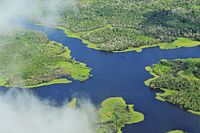
Environmental laws are laws that protect the environment. Environmental law is the collection of laws, regulations, agreements and common law that governs how humans interact with their environment. This includes environmental regulations; laws governing management of natural resources, such as forests, minerals, or fisheries; and related topics such as environmental impact assessments. Environmental law is seen as the body of laws concerned with the protection of living things from the harm that human activity may immediately or eventually cause to them or their species, either directly or to the media and the habits on which they depend.

The environmental movement, is a social movement that aims to protect the natural world from harmful environmental practices in order to create sustainable living. Environmentalists advocate the just and sustainable management of resources and stewardship of the environment through changes in public policy and individual behavior. In its recognition of humanity as a participant in ecosystems, the movement is centered on ecology, health, as well as human rights.

The Supreme Court of India is the supreme judicial authority and the highest court of the Republic of India. It is the final court of appeal for all civil and criminal cases in India. It also has the power of judicial review. The Supreme Court, which consists of the Chief Justice of India and a maximum of fellow 33 judges, has extensive powers in the form of original, appellate and advisory jurisdictions.

The Alien Tort Statute, also called the Alien Tort Claims Act (ATCA), is a section in the United States Code that gives federal courts jurisdiction over lawsuits filed by foreign nationals for torts committed in violation of international law. It was first introduced by the Judiciary Act of 1789 and is one of the oldest federal laws still in effect in the U.S.
The chief instrument through which judicial activism has flourished in India is public interest litigation (PIL) or social action litigation (SAL). It refers to litigation undertaken to secure public interest and demonstrates the availability of justice to socially-disadvantaged parties and was introduced by Justice P. N. Bhagwati and Justice V.R. Krishna Iyer. It is a relaxation on the traditional rule of locus standi. Before 1980s the judiciary and the Supreme Court of India entertained litigation only from parties affected directly or indirectly by the defendant. It heard and decided cases only under its original and appellate jurisdictions. However, the Supreme Court began permitting cases on the grounds of public interest litigation, which means that even people who are not directly involved in the case may bring matters of public interest to the court. It is the court's privilege to entertain the application for the PIL.

The Atrato River is a river of northwestern Colombia. It rises in the slopes of the Western Cordillera and flows almost due north to the Gulf of Urabá, where it forms a large, swampy delta. Its course crosses the Chocó Department, forming that department's border with neighboring Antioquia in two places. Its total length is about 650 km (400 mi), and it is navigable as far as Quibdó, the capital of the department.

The human right to water and sanitation (HRWS) is a principle stating that clean drinking water and sanitation are a universal human right because of their high importance in sustaining every person's life. It was recognized as a human right by the United Nations General Assembly on 28 July 2010. The HRWS has been recognized in international law through human rights treaties, declarations and other standards. Some commentators have based an argument for the existence of a universal human right to water on grounds independent of the 2010 General Assembly resolution, such as Article 11.1 of the International Covenant on Economic, Social and Cultural Rights (ICESCR); among those commentators, those who accept the existence of international ius cogens and consider it to include the Covenant's provisions hold that such a right is a universally binding principle of international law. Other treaties that explicitly recognize the HRWS include the 1979 Convention on the Elimination of All Forms of Discrimination Against Women (CEDAW) and the 1989 Convention on the Rights of the Child (CRC).

Dhananjaya Yeshwant Chandrachud is an Indian jurist, who is the 50th and Current Chief Justice of India serving since November 2022. He was appointed a judge of the Supreme Court of India in May 2016. He has also previously served as the chief justice of the Allahabad High Court from 2013 to 2016 and as a judge of the Bombay High Court from 2000 to 2013. He is also a former executive chairperson (ex officio) of the National Legal Services Authority.

The Declaration on the Rights of Indigenous Peoples is a legally non-binding resolution passed by the United Nations in 2007. It delineates and defines the individual and collective rights of indigenous peoples, including their ownership rights to cultural and ceremonial expression, identity, language, employment, health, education, and other issues. Their ownership also extends to the protection of their intellectual and cultural property. The declaration "emphasizes the rights of Indigenous peoples to maintain and strengthen their own institutions, cultures and traditions, and to pursue their development in keeping with their own needs and aspirations." It "prohibits discrimination against indigenous peoples," and it "promotes their full and effective participation in all matters that concern them and their right to remain distinct and to pursue their own visions of economic and social development".

The primacy of European Union law is a legal principle establishing precedence of European Union law over conflicting national laws of EU member states.
Indigenous rights are those rights that exist in recognition of the specific condition of the Indigenous peoples. This includes not only the most basic human rights of physical survival and integrity, but also the rights over their land, language, religion, and other elements of cultural heritage that are a part of their existence and identity as a people. This can be used as an expression for advocacy of social organizations, or form a part of the national law in establishing the relation between a government and the right of self-determination among its Indigenous people, or in international law as a protection against violation of Indigenous rights by actions of governments or groups of private interests.

Abortion in Colombia is freely available on request up to the 24th week of pregnancy, due to a ruling by the Constitutional Court on February 21, 2022. Later in pregnancy, it is only allowed in cases of risk of death to the pregnant woman, fetal malformation, or rape, according to a Constitutional Court ruling in 2006.
The Law of the Rights of Mother Earth is a Bolivian law, that was passed by Bolivia's Plurinational Legislative Assembly in December 2010. This 10 article law is derived from the first part of a longer draft bill, drafted and released by the Pact of Unity by November 2010.
With the adoption of a new constitution in 2008 under president Rafael Correa, Ecuador became the first country in the world to enshrine a set of codified Rights of Nature and to inform a more clarified content to those rights. Articles 10 and 71–74 of the Ecuadorian Constitution recognize the inalienable rights of ecosystems to exist and flourish, give people the authority to petition on the behalf of nature, and requires the government to remedy violations of these rights.

Monica Feria Tinta is a British/Peruvian barrister, a specialist in public international law, at the Bar of England & Wales. She practises from Twenty Essex, London.

Rights of nature or Earth rights is a legal and jurisprudential theory that describes inherent rights as associated with ecosystems and species, similar to the concept of fundamental human rights. The rights of nature concept challenges twentieth-century laws as generally grounded in a flawed frame of nature as "resource" to be owned, used, and degraded. Proponents argue that laws grounded in rights of nature direct humanity to act appropriately and in a way consistent with modern, system-based science, which demonstrates that humans and the natural world are fundamentally interconnected.

Environmental personhood or juridic personhood is a legal concept which designates certain environmental entities the status of a legal person. This assigns to these entities, the rights, protections, privileges, responsibilities and legal liability of a legal personality. Because environmental entities such as rivers and plants can not represent themselves in court, a "guardian" can act on the entity's behalf to protect it. Environmental personhood emerged from the evolution of legal focus in pursuit of the protection of nature. Over time, focus has evolved from human interests in exploiting nature, to protecting nature for future human generations, to conceptions that allow for nature to be protected as intrinsically valuable. This concept can be used as a vehicle for recognising Indigenous peoples' relationships to natural entities, such as rivers. Environmental personhood, which assigns nature certain rights, concurrently provides a means to individuals or groups such as Indigenous peoples to fulfill their human rights.

Climate change litigation, also known as climate litigation, is an emerging body of environmental law using legal practice to set case law precedent to further climate change mitigation efforts from public institutions, such as governments and companies. In the face of slow climate change politics delaying climate change mitigation, activists and lawyers have increased efforts to use national and international judiciary systems to advance the effort. Climate litigation typically engages in one of five types of legal claims: Constitutional law, administrative law, private law (challenging corporations or other organizations for negligence, nuisance, etc., fraud or consumer protection, or human rights.
The Global Pact for the Environment project was launched in 2017 by a network of experts known as the "International Group of Experts for the Pact" (IGEP). The group is made up of more than a hundred legal experts in environmental law and is chaired by former COP21 President Laurent Fabius.

The right to a healthy environment or the right to a sustainable and healthy environment is a human right advocated by human rights organizations and environmental organizations to protect the ecological systems that provide human health. The right was acknowledged by the United Nations Human Rights Council during its 48th session in October 2021 in HRC/RES/48/13 and subsequently by the United Nations General Assembly on July 28, 2022 in A/RES/76/300. The right is often the basis for human rights defense by environmental defenders, such as land defenders, water protectors and indigenous rights activists.





![Atrato River in Colombia - in a 2016 ruling by the Constitutional Court involving the river's pollution, the court stated that the river is a subject of rights, and that humans are "only one more event within a long evolutionary chain [and] in no way... owner of other species, biodiversity or natural resources, or the fate of the planet". BETE donde creci, ahora Municio del medio Atrato Rio 03.JPG](http://upload.wikimedia.org/wikipedia/commons/thumb/6/62/BETE_donde_creci%2C_ahora_Municio_del_medio_Atrato_Rio_03.JPG/220px-BETE_donde_creci%2C_ahora_Municio_del_medio_Atrato_Rio_03.JPG)















